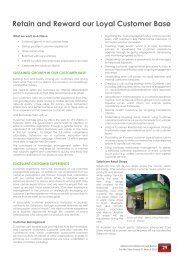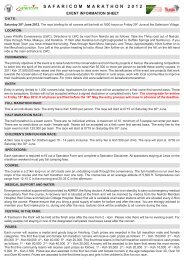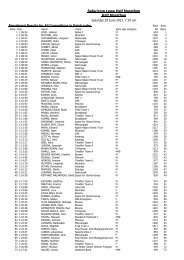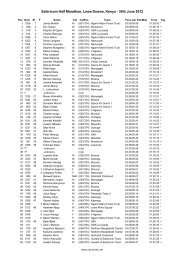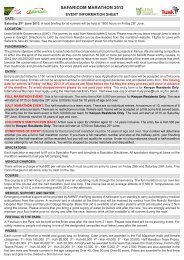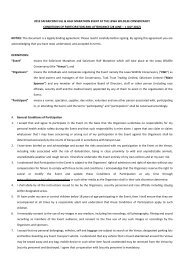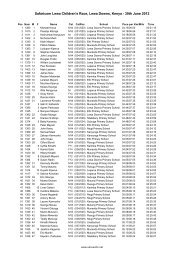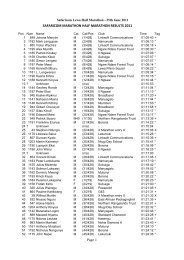Sustainability Performance: At a glance (31 March 2012) - Safaricom
Sustainability Performance: At a glance (31 March 2012) - Safaricom
Sustainability Performance: At a glance (31 March 2012) - Safaricom
You also want an ePaper? Increase the reach of your titles
YUMPU automatically turns print PDFs into web optimized ePapers that Google loves.
Energy Security<br />
How we performed<br />
The following tables detail our electricity and diesel consumption for the 2011/<strong>2012</strong> financial year.<br />
Electricity<br />
Facilities Network<br />
BTSs MSRs<br />
Megawatt Hours (Mwh) 8 538.8 78 040.52 <strong>31</strong> 653.46<br />
Gigajoules (GJ) 30 739.68 280 945.88 113 952.47<br />
Diesel<br />
Facilities Network<br />
BTSs MSRs<br />
Volume (Litres) 244 518 7 345 436.52 834 608.88<br />
Gigajoules (GJ) 8 866.08 266 341.23 30 262.43<br />
* The buildings data is based on monthly bills received from KPLC and includes <strong>Safaricom</strong> Headquarter I and II and the<br />
Jambo Contact Centre, but excludes the <strong>Safaricom</strong> Care Centre (SCC), which is measured as part of the Technical Network<br />
electricity consumption.<br />
Benchmarking energy performance<br />
As this is our first sustainability report, no formal benchmarks<br />
have yet been established for our energy performance. One<br />
of our overall objectives in financial year (FY) 2013 is to<br />
improve efficiency in diesel and electricity consumption In<br />
FY 2013, we will also establish energy performance baseline<br />
data that can be used to benchmark us against other<br />
Vodafone companies going forward.<br />
Other initiatives<br />
Other initiatives under trial include: biofuels, hydrogen fuel cells and grid extensions<br />
(<strong>Safaricom</strong> constructs up to 6km of power lines in off-grid areas to substantially<br />
reduce generator running hours). These trials will be reported on at the end of the<br />
current financial year.<br />
Lighting the way<br />
LED lights are currently being installed at the Jambo Call<br />
Centre in Mlolongo, all future retail shops will incorporate<br />
LED lighting and, in existing retail shops, a phased<br />
replacement of the existing incandescent fluorescent<br />
lamps will be implemented in the new financial year. By 1<br />
April 2013, all retail shops will be lit using LED lights.<br />
Facilities energy management initiatives<br />
Digital Addressable Lighting Interface<br />
<strong>Safaricom</strong> House II has had the latest Digital<br />
Addressable Lighting Interface (DALI)<br />
installed. The DALI adjusts the lighting levels<br />
in the main work areas based on the intensity<br />
of external lighting, optimising lighting power<br />
consumption throughout the building.<br />
LED Lighting<br />
LED lighting has been installed<br />
in all the main administration<br />
facilities, resulting in a substantial<br />
40% reduction in energy<br />
consumed. Plans are in progress<br />
to install LED lighting in all retail<br />
shop facilities during the next<br />
financial year.<br />
Network energy management initiatives<br />
Immediately after deployment, the network-related energy efficiency initiatives described below had the cumulative effect of reducing<br />
the running hours (and carbon emissions) of our diesel generators by approximately 67%.<br />
Power Management Units (PMUs)<br />
By stabilising the quality of grid supply (reducing voltage<br />
fluctuations, conditioning voltages, isolating bad power,<br />
regulating under and over-voltages, regulating generator<br />
running and monitoring battery condition) these reduce<br />
unnecessary generator running and diesel consumption.<br />
Auto Phase Selectors (APS)<br />
Similar to the PMUs, these<br />
check voltage phases<br />
and isolate unhealthy grid<br />
phases, delaying generator<br />
running in case voltage<br />
tolerances are not met.<br />
Merged Electrical Systems<br />
Previously, the power supplied<br />
to <strong>Safaricom</strong> Houses I and II was<br />
supported by different electrical and<br />
generator systems. By integrating<br />
these systems, we have been able to<br />
achieve reduced generator running<br />
hours, lower exhaust emissions and<br />
reduced diesel consumption.<br />
Building Management System<br />
Jambo Contact Centre, <strong>Safaricom</strong> Care<br />
Centre and <strong>Safaricom</strong> House II feature a fully<br />
integrated building management system,<br />
incorporating occupation-based lighting and<br />
air-conditioning control. The system has<br />
enabled the company to monitor and control<br />
building systems, increasing energy efficiency.<br />
Automatic Voltage Regulators (AVRs)<br />
These stabilise input voltages and are ideal for sites<br />
with very high and very low voltages.<br />
Vanadium Redox Batteries<br />
Switching from Lead Acid<br />
batteries to these high-cycle,<br />
deep-discharge batteries<br />
also significantly reduces<br />
generator running hours and<br />
diesel consumption.<br />
Energy Security<br />
Power Factor Correction Banks<br />
Office and administrative facilities<br />
have had power factor correction<br />
banks installed as part of the<br />
electrical system. This ensures<br />
efficient delivery of power and that<br />
<strong>Safaricom</strong> only draws from the<br />
national grid the actual load it utilises.<br />
60 <strong>Safaricom</strong> <strong>Sustainability</strong> Report <strong>2012</strong> <strong>Safaricom</strong> <strong>Sustainability</strong> Report <strong>2012</strong> 61



